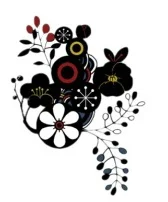
The tokonoma is a distinctive feature found in Japanese architecture, particularly in formal guest rooms.
It is a designated space that holds great cultural and historical significance, serving as a focal point for the display of art and decorative items.
In this article, we will explore the history, purpose, types, and structure of the tokonoma, as well as its etiquette and taboos.
{tocify} $title={Table of Contents}
History of Tokonoma
The tokonoma originally emerged from Buddhist temples, where it was used to house Buddhist statues and sacred objects.
It then found its way into the residences of the samurai class and gradually became a symbol of status and refinement.
During the Nanboku-cho period, the tokonoma, along with other architectural elements like tsuke shoin and chigaidana, began to be incorporated into the design of reception rooms.
It wasn't until the early modern period, with the development of shoin-zukuri and sukiya-zukuri, that the tokonoma reached its full potential as a decorative feature.
The cultural significance of the tokonoma extended beyond Japan's borders.
As Japanese traditional architecture gained international recognition, the concept of a designated space for displaying art and seasonal decorations inspired Western architects and designers.
The tokonoma's influence can be seen in the incorporation of fixed display areas in Western homes and the practice of rotating artwork based on the seasons.
Purpose of Tokonoma
The primary purpose of the tokonoma is to serve as a space for the display of art, calligraphy, flower arrangements, and other decorative items.
It is often located in the kamiza or upper part of the room, which is considered the most prestigious area.
The items placed in the tokonoma are carefully chosen to reflect the season, the occasion, or the personal taste of the host.
In addition to its decorative function, the tokonoma also serves as a focal point for social interactions.
Guests are seated facing the tokonoma, and it becomes a topic of conversation and admiration.
The aesthetics of the tokonoma, including the arrangement of items, the choice of materials, and the interplay of light and shadow, contribute to the overall ambiance of the room and create a sense of harmony and tranquility.
Types of Tokonoma
There are various types of tokonoma, each with its own characteristics and design elements.
Some common types include:
- Fumikomi-doko: A type of tokonoma where the floor is raised to the same level as the tatami mats.
- Kekomi-doko: The floor of this tokonoma is raised higher than the tatami mats, creating a step-like effect.
- Fukuro-doko: This type of tokonoma features a narrow wall that partially separates it from the rest of the room, creating a pocket-like space.
- Oki-doko: A movable and simplified version of the tokonoma, often used in modern homes.
Structure of Tokonoma
The tokonoma is composed of several elements that contribute to its overall structure and aesthetics.
The key components include:
- Tokobashira: The main pillar of the tokonoma, often made from high-quality wood or adorned with decorative carvings.
- Toko-ita: The raised platform that defines the space of the tokonoma. It is usually covered with a tatami mat or wooden flooring.
- Toko-gamachi: A decorative frame or border that separates the tokonoma from the rest of the room.
The arrangement and composition of these elements vary depending on the style and design of the tokonoma.
The choice of materials, colors, and textures also contributes to the overall aesthetic appeal.
Etiquette and Taboos
The tokonoma has its own set of customs and etiquette that should be observed when interacting with it.
Here are some important points to keep in mind:
- Seating: When entering a room with a tokonoma, guests should take their seats facing the tokonoma.
- Conversations: The items displayed in the tokonoma can serve as conversation starters. Guests can discuss the art, the season, or any other topic related to the display.
- Respect: It is important to show respect and appreciation for the items in the tokonoma. Avoid touching or moving them without permission.
- Taboos: Certain actions are considered taboo when it comes to the tokonoma.These include sitting or stepping on the raised platform, placing dirty or inappropriate objects in the tokonoma, and using it as a storage space.
By following these etiquette guidelines, guests can fully appreciate the beauty and cultural significance of the tokonoma.
Conclusion
The tokonoma stands as a testament to the rich cultural heritage of Japan.
Its evolution from Buddhist temples to samurai residences and its influence on Western architecture demonstrates its enduring appeal.
As a space dedicated to the display of art and decorative items, the tokonoma enriches the ambiance of a room and serves as a focal point for social interactions.
By understanding and respecting the customs associated with the tokonoma, one can fully appreciate its beauty and significance in Japanese architecture.
Additional Information
The tokonoma is often adorned with a kakejiku (hanging scroll) that features calligraphy or a painting.
During tea ceremonies, the tokonoma may hold a chabana (tea flower arrangement) that complements the theme or season of the ceremony. The choice of items displayed in the tokonoma can vary based on personal preferences, cultural traditions, or the occasion.

Your Gateway to Japan's Wonders! Immerse yourself in the beauty, culture, and adventures that Japan has to offer.
Check It Out!
Post a Comment